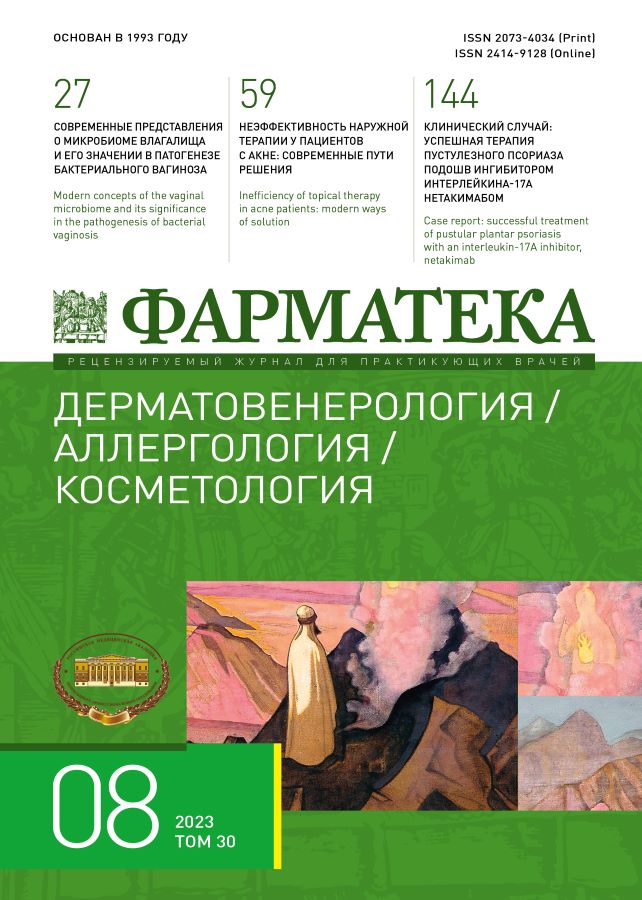Amino acid replacement therapy as preparation and enhancement of the effectiveness of collagen-stimulating methods
- 作者: Svechnikova E.V.1,2, Morzhanaeva M.A.3, Gorskaya A.A.4,5
-
隶属关系:
- Polyclinic № 1 of the Administrative Department of the President of the Russian Federation
- Russian Biotechnological University
- Skin Art Clinic
- PLA-based drugs manufacturing plant
- O’LIVE Aesthetic Medicine Clinic
- 期: 卷 30, 编号 8 (2023)
- 页面: 83-90
- 栏目: Original articles
- URL: https://journals.eco-vector.com/2073-4034/article/view/623096
- DOI: https://doi.org/10.18565/pharmateca.2023.8.83-90
- ID: 623096
如何引用文章
详细
Background. The main component of the dermis is collagen, an organic compound of a group of fibrillar proteins. The papillary dermis is formed by smaller bundles of collagen fibers with predominance of fibroblasts, fibrocytes, mast cells, T-lymphocytes, while the reticular dermis is characterized by larger bundles that form a characteristic network providing strength to the skin, hence the name of the layer – reticular. In young skin, collagen type I (80%) and III (15%) fibers with ratio 6:1 predominate. With age, there is a decrease in the content of type I collagen, which leads to a thickening and disruption of the bonds between the fibers. Most cosmetic procedures are aimed at collagen stimulation; before stimulating collagen production, however, it is necessary to provide cells with essential amino acids for the synthesis of collagen types I and III and direct inflammation in a controlled way. Amino acid replacement therapy (AART) is a fundamental step in preparing patients for invasive procedures. In this article, for the first time, for the diagnosis of undifferentiated connective tissue dysplasia (UCTD) of patients, the «UCTD diagnostic genetic panel» developed by the authors and the questionnaire for UCTD screening in cosmetology practice were used.
Objective. Improvement of the effectiveness of skin correction protocols during collagen-stimulating procedures, development of screening questionnaire for the detection of UCTD in cosmetology practice, testing of a genetic panel to identify signs of UCTD during collagen stimulation, development of correction protocols based on the data obtained.
Methods. The study included three patients who received a complex correction protocol based on polylactic acid and AART.
Results. Due to the combined use of the UCTD screening questionnaire in cosmetology practice and genetic panels, the authors managed to achieve pronounced results when using collagen-stimulating methods in patients and prevent possible complications.
Conclusion. General approaches to the diagnosis of UCTD should be based on a comprehensive analysis of the results of clinical and laboratory tests. The capabilities of genetic panels in combination with a screening questionnaire make it possible to achieve pronounced results and avoid possible complications.
全文:
作者简介
Elena Svechnikova
Polyclinic № 1 of the Administrative Department of the President of the Russian Federation; Russian Biotechnological University
编辑信件的主要联系方式.
Email: elene-elene@bk.ru
ORCID iD: 0000-0002-5885-4872
Dr. Sci. (Med.), Head of the Department of Dermatovenereology and Cosmetology; Professor at the Department of Skin and Venereal Diseases
俄罗斯联邦, Moscow; MoscowM. Morzhanaeva
Skin Art Clinic
Email: elene-elene@bk.ru
ORCID iD: 0000-0001-8657-9559
俄罗斯联邦, Moscow
A. Gorskaya
PLA-based drugs manufacturing plant; O’LIVE Aesthetic Medicine Clinic
Email: elene-elene@bk.ru
ORCID iD: 0000-0003-0314-7035
韩国, Korea; Nizhny Novgorod, Russia
参考
- Arseni L., Lombardi A., Orioli D. From structure to phenotype: impact of collagen alterations on human health. Int J Mol Sci. 2018;19(5):1407. doi: 10.3390/ijms19051407.
- Демидов Р.О., Лапшина С.А., Якупова С.П., Мухина Р.Г. Дисплазия соединительной ткани: современные подходы к клинике, диагностике и лечению. Инновационные технологии в медицине. 2015;2(89):37–40. [Demidov R.O., Lapshina S.A., Yakupova S.P., Mukhina R.G. Connective tissue dysplasia: current approaches to the clinic, diagnosis and treatment. Innovatsionnye tekhnologii v meditsine. 2015;2(89):37–40 (In Russ.)].
- Сметанин М.Ю., Нургалиева С.Ю., Кононо-ва Н.Ю. и др. Минеральная плотность костной ткани и маркеры костного метаболизма у женщин с дисплазией соединительной ткани. Практическая медицина. 2019;17(4):102–6. [Smetanin M.Yu., Nurgalieva S.Yu., Kononova N.Yu., et al. Bone mineral density and bone turnover markers in women with connective tissue dysplasia. Prakticheskaya meditsina. 2019;17(4):102–6. (In Russ.)]. doi: 10.32000/2072-1757-2019-4-102-106.
- Ляховецкий Б.И., Глазкова Л.К., Перетолчина Т.Ф. Дисплазия соединительной ткани: роль коллагеновых белков дермы (обзор литературы). Российский журнал кожных и венерических болезней. 2012;3:19–22. [Lyakhovetsky B.I., Glazkova L.K, Peretolchina T.F. Connective tissue dysplasia: significance of dermal collagen proteins (review of literature). Rossiiskii zhurnal kozhnykh i venericheskikh boleznei. 2012;3:19–22 (In Russ.)].
- Jones M.G., Andriotis O.G., Roberts J.J., et al. Nanoscale dysregulation of collagen structure-function disrupts mechano-homeostasis and mediates pulmonary fibrosis. Elife. 2018;3(7):e36354. doi: 10.7554/eLife.36354.
- Jansen K.A., Licup A.J., Sharma A., et al. The role of network architecture in collagen mechanics. Biophys J. 2018;114(11):2665–78. doi: 10.1016/j.bpj.2018.04.043.
- Кильдиярова Р.Р., Углова Д.Ф. Ассоциированная с дисплазией соединительной ткани кардиальная патология у женщин и их новорожденных детей. Российский вестник перинатологии и педиатрии. 2015;2(60):54–6. [Kil’diyarova R.R., Uglova D.F. Associirovannaya s displaziej soedinitel’noj tkani kardial’naya patologiya u zhenshchin i ih novorozhdennyh detej (Connective tissue dysplasia-associated cardiac pathology in women and their newborns.). Rossiiskii vestnik perinatologii i pediatrii. 2015;2(60):54–6. (In Russ.)].
- Нохсорова М.А., Борисова Н.В., Аммосова А.М. Возможность диагностики недифференцированной дисплазии соединительной ткани с помощью биологических маркеров. Вестн. новых медицинских технологий. Электронное издание. 2019;4. [Nokhsorova M.A., Borisovа N.V., Ammosova A.M. Possibility of diagnostics undifferentiated connective tissue dysplasia using biological markers. J New Med Technol. E-edition. 2019;4. (In Russ.)]. URL: http://www.medtsu.tula.ru/VNMT/Bulletin/E2019-4/3-3.pdf (19.03.2021). doi: 10.24411/2075-4094-2019-1643.
- Hood L., Rowen L. The Human Genome Project: big science transforms biology and medicine. Genome Med. 2013;5(9):79.
- Ahn J.H., Noh Y.H., Um K.J., et al. Vitamin D status and vitamin D receptor gene polymorphisms are associated with pelvic floor disorders in women. J Menopausal Med. 2018;24(2):119–26. doi: 10.6118/jmm.2018.24.2.119.
- Zamborsky R., Kokavec M., Harsanyi S., et al. Developmental Dysplasia of Hip: Perspectives in Genetic Screening. Med Sci (Basel). 2019;7(4):59. doi: 10.3390/medsci7040059.
- MacFarlane E.G., Haupt J., Dietz H.C., Shore E.M. TGF-β Family Signaling in Connective Tissue and Skeletal Diseases. Cold Spring Harb Perspect. Biol. 2017;9(11):a022269. doi: 10.1101/cshperspect.a022269.
- Ritelli M., Colombi M. Molecular genetics and pathogenesis of ehlers-danlos syndrome and related connective tissue disorders. Genes (Basel). 2020;11(5):547. doi: 10.3390/genes11050547.
- Mosca M. Mixed connective tissue diseases: new aspects of clinical picture, prognosis and pathogenesis. Isr Med Assoc J. 2014; 16(11):725–26.














